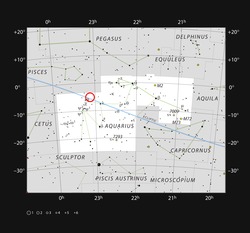TRAPPIST-1
 This chart shows the naked-eye stars visible on a clear, dark night in the constellation Aquarius (the Water Carrier). The position of the very red ultracool dwarf star TRAPPIST-1 is marked. Although it is relatively close to the Sun, it is very faint and not visible in small telescopes. Credit: ESO/IAU and Sky & Telescope |
|
| Observation data Epoch Equinox |
|
|---|---|
| Constellation | Aquarius |
| Right ascension | 23h 06m 29.283s |
| Declination | –05° 02′ 28.59″ |
| Apparent magnitude (V) | 18.80 |
| Characteristics | |
| Spectral type | M8V |
| V−R color index | 2.33 |
| R−I color index | 2.47 |
| Astrometry | |
| Radial velocity (Rv) | −56.3 km/s |
| Parallax (π) | 82.58 mas |
| Distance | 39.5 ± 1.3 ly (12.1 ± 0.4 pc) |
| Absolute magnitude (MV) | 18.4 ± 0.1 |
| Details | |
| Mass | 0.08 ± 0.009 M☉ |
| Mass | 83.8048 ± 9.428 MJup |
| Radius | 0.114 ± 0.006 R☉ |
| Luminosity (bolometric) | 0.000525±0.000036 L☉ |
| Luminosity (visual, LV) | 0.00000373 L☉ |
| Surface gravity (log g) | ~5.227 cgs |
| Temperature | 2550 ± 55 K |
| Metallicity | 0.04 ± 0.08 |
| Rotation | 1.40 ± 0.05 days |
| Rotational velocity (v sin i) | 6 ± 2 km/s |
| Age | > 0.5000 Gyr |
| Other designations | |
|
2MASS J23062928-0502285, 2MASSI J2306292-050227, 2MASSW J2306292-050227, 2MUDC 12171
|
|
| Database references | |
| SIMBAD | data |
TRAPPIST-1, also known as 2MASS J23062928-0502285, is an ultracool dwarf star located 39.13 light-years (12.0 pc) away in the constellation Aquarius.
A team of astronomers headed by Michaël Gillon of the Institut d’Astrophysique et Géophysique at the University of Liège in Belgium used the TRAPPIST (Transiting Planets and Planetesimals Small Telescope) telescope at the La Silla Observatory in the Atacama desert, Chile, to observe TRAPPIST-1 and search for orbiting planets. By utilising transit photometry, they discovered three Earth-sized planets orbiting the dwarf star; the innermost two are tidally locked to their host star while the outermost appears to lie either within the system's habitable zone or just outside of it. The team made their observations from September to December 2015 and published its findings in the May 2016 issue of the journal Nature.
On 22 February 2017, NASA announced that using the Spitzer Space Telescope, they had discovered four additional exoplanets around TRAPPIST-1. This brought the total number of planets orbiting the star to seven, three of which are in its habitable zone. Although it is possible, that all seven planets may be in the habitable zone.
The designation b, c and d derive from the order of discovery. The designation of b is given to the first planet orbiting a given star, and d to the furthest. In the case of TRAPPIST-1, three were discovered, which were designated b, c and d, in order of increasing orbital periods. The name TRAPPIST-1 derives directly from the fact that the star is the catalogued 1st star discovered by the TRAPPIST telescope to have transiting planets.
TRAPPIST-1 is an ultracool dwarf star that is approximately 8% the mass of and 11% the radius of the Sun. It has a temperature of 2550 K and is at least 500 million years old. In comparison, the Sun is about 4.6 billion years old and has a temperature of 5778 K.
...
Wikipedia
